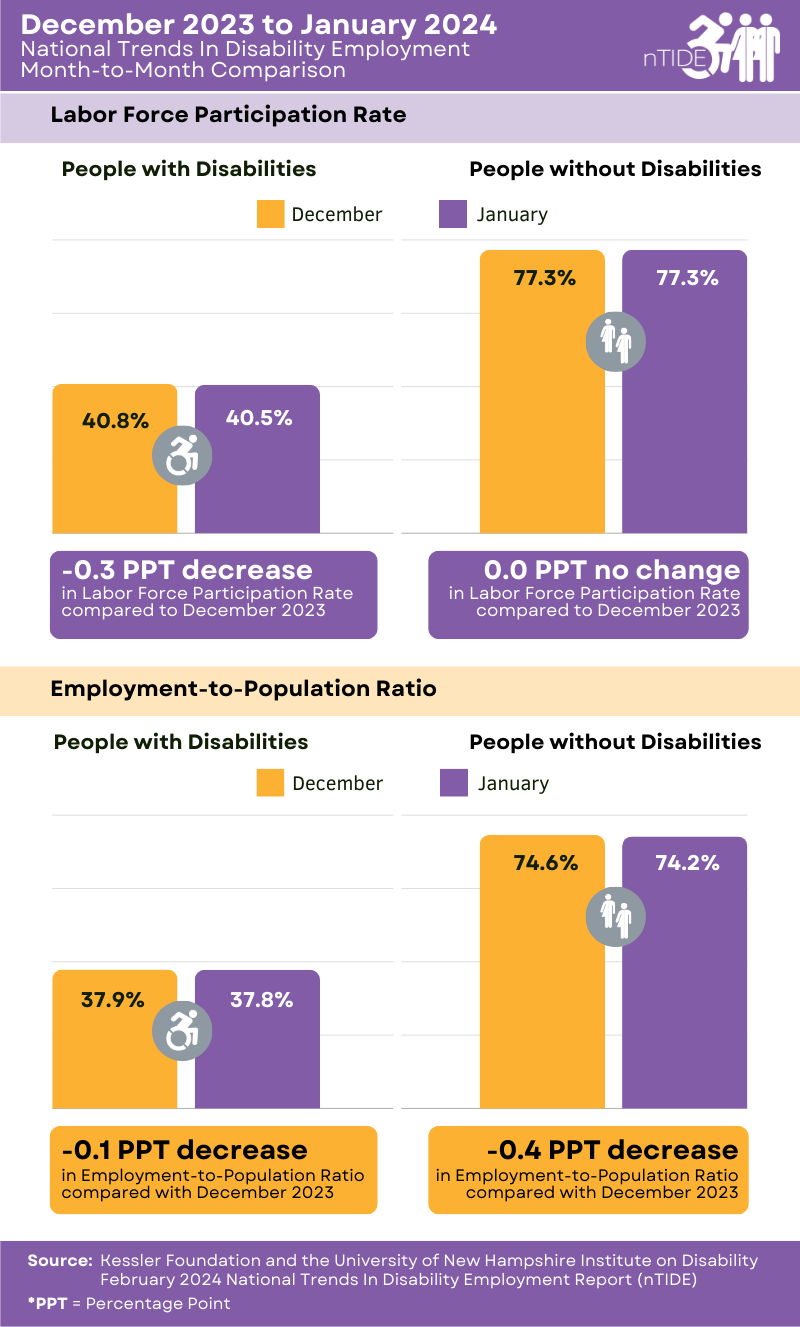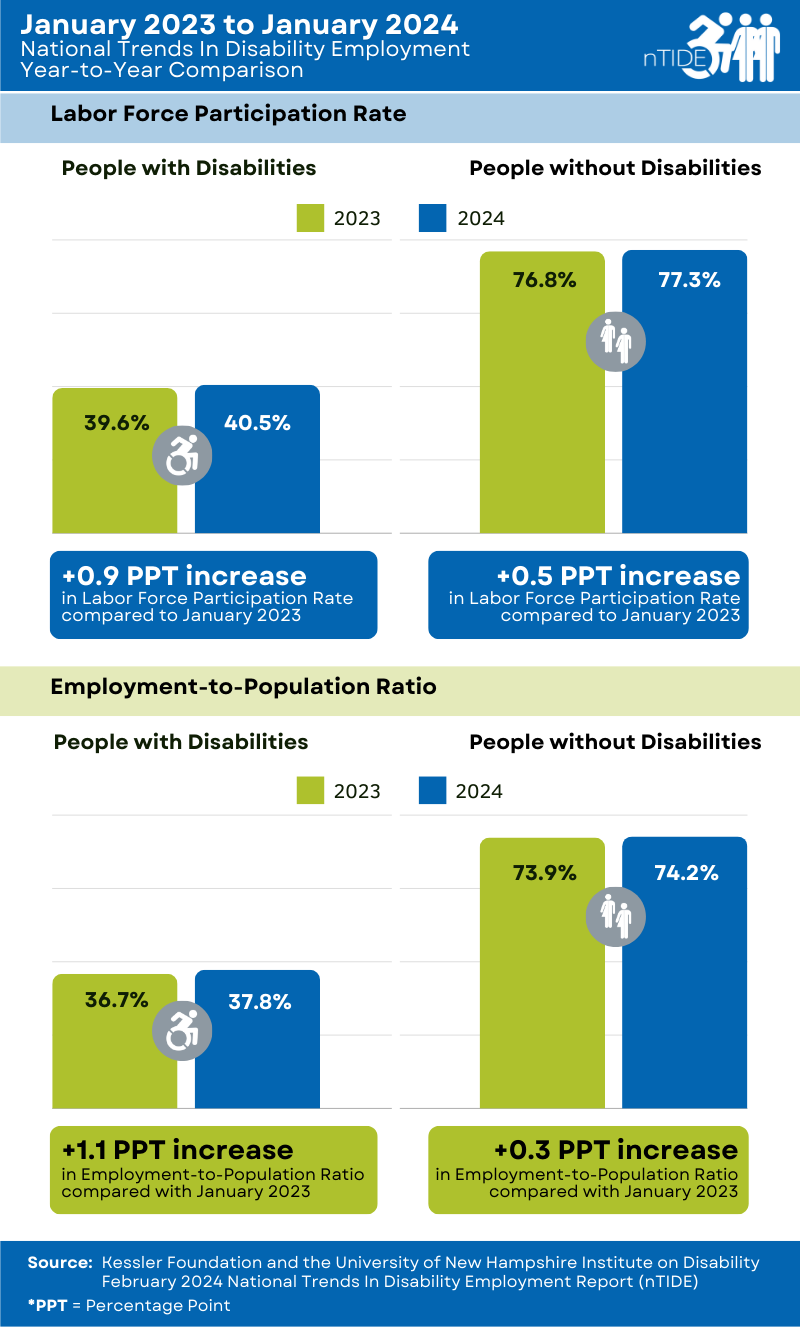National Trends in Disability Employment (nTIDE) – Issued semi-monthly by Kessler Foundation and the University of New Hampshire.
East Hanover, NJ – March 8, 2024 – Despite recent declines in the labor force participation rate and employment-to-population ratio, the overall employment remains positive for people with disabilities, according to today’s National Trends in Disability Employment – semi-monthly update (nTIDE), issued by Kessler Foundation and the University of New Hampshire’s Institute on Disability (UNH-IOD).
Month-to-Month nTIDE Numbers (comparing January 2024 to February 2024)
Based on data from the U.S. Bureau of Labor Statistics (BLS) Jobs Report released today, the employment-to-population ratio for people with disabilities (ages 16-64) decreased from 37.8 percent in January 2024 to 36.7 percent in February 2024 (down 2.9 percent or 1.1 percentage points). For people without disabilities (ages 16-64), the employment-to-population ratio increased from 74.2 percent in January 2024 to 74.6 percent in February 2024 (up 0.5 percent or 0.4 percentage points). The employment-to-population ratio, a key indicator, reflects the percentage of people who are working relative to the total population (the number of people working divided by the number of people in the total population multiplied by 100).

showing decreases in the labor force participation rate employment-to-population ratio and
for people with disabilities. Both indicators increased slightly for people without disabilities.
“Similar to last month, we saw a decline in the employment-to-population ratio for people with disabilities in February,” said John O’Neill, PhD, director of the Center for Employment and Disability Research at Kessler Foundation. “This appears to be consistent with early spring declines we have seen in the past for this population,” he noted.
The labor force participation rate for people with disabilities (ages 16-64) decreased from 40.5 percent in January 2024 to 40.1 percent in February 2024 (down 1 percent or 0.4 percentage points). For people without disabilities (ages 16-64), the labor force participation rate increased from 77.3 percent in January 2024 to 77.7 percent in February 2024 (up 0.5 percent or 0.4 percentage points). The labor force participation rate reflects the percentage of people who are in the labor force (working, on temporary layoff (on furlough), or actively looking for work in the last four weeks) relative to the total population (the number of people in the labor force divided by the number of people in the total population multiplied by 100).
“Although their percentage employed declined, people with disabilities largely remained in the labor force, which is a good sign for next month’s numbers,” said Andrew Houtenville, PhD, professor of economics and research director of the UNH-IOD.
Year-to-Year nTIDE Numbers (comparing February 2023 to February 2024)
The employment-to-population ratio for people with disabilities (ages 16-64) decreased from 36.9 percent in February 2023 to 36.7 percent in February 2024 (down 0.5 percent or 0.2 percentage points). For people without disabilities (ages 16-64), the employment-to-population ratio increased slightly from 74.4 percent in February 2023 to 74.6 percent in February 2024 (up 0.3 percent or 0.2 percentage points).

showing decreases for people with disabilities and increases for people without disabilities.
.
Similarly, the labor force participation rate for people with disabilities (ages 16-64) decreased from 40.2 percent in February 2023 to 40.1 percent in February 2024 (down 0.2 percent or 0.1 percentage points). For people without disabilities (ages 16-64), the labor force participation rate also increased from 77.3 percent in February 2023 to 77.7 percent in February 2024 (up 0.5 percent or 0.4 percentage points).
In February, among workers ages 16-64, the 6,194,000 workers with disabilities represented 4.2 percent of the total 149,243,000 workers in the U.S.
Ask Questions about Disability and Employment
Each nTIDE release is followed by an nTIDE Lunch & Learn online webinar. This live broadcast, hosted via Zoom Webinar, offers attendees Q&A on the latest
nTIDE findings, provides news, updates from the field, and features invited panelists who discuss current disability-related findings and events.
On March 8, 2024, from 12:00 pm – 1:00 pm Eastern, guest presenter Patricia D. Gill, JD, director of Workforce Development at the National Restaurant Association Educational Foundation (NRAEF), joins Drs. Houtenville and O’Neill and Denise Rozell from AUCD. Join our free Lunch & Learn live or visit the nTIDE archives at: ResearchonDisability.org/nTIDE. Also, register now for our mid-month Deeper Dive into employment trends at nTIDE Deeper Dive – 03/22/2024.
NOTE: The statistics in the nTIDE are based on BLS numbers but are not identical. They are customized by UNH to combine the statistics for men and women of working age (16- 64). nTIDE is funded by the National Institute on Disability, Independent Living and Rehabilitation Research (NIDILRR; 90RTGE0005) and Kessler Foundation.
About the Institute on Disability at the University of New Hampshire
The Institute on Disability (IOD) at the University of New Hampshire (UNH) was established in 1987 to provide a university-based focus for the improvement of knowledge, policies, and practices related to the lives of persons with disabilities and their families. For information on the NIDILRR-funded Research and Training Center on Disability Statistics, visit ResearchOnDisability.org.
About Kessler Foundation
Kessler Foundation, a major nonprofit organization in the field of disability, is a global leader in rehabilitation research. Our scientists seek to improve cognition, mobility, and long-term outcomes, including employment, for adults and children with neurological and developmental disabilities of the brain and spinal cord including traumatic brain injury, spinal cord injury, stroke, multiple sclerosis, and autism. Kessler Foundation also leads the nation in funding innovative programs that expand opportunities for employment for people with disabilities. For more information, visit KesslerFoundation.org.